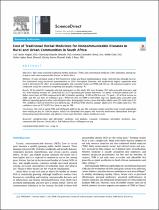| dc.contributor.author | Gail Denise, Hughes | |
| dc.contributor.author | Oluwaseyi Mayode, Aboyade | |
| dc.date.accessioned | 2022-09-15T13:24:48Z | |
| dc.date.available | 2022-09-15T13:24:48Z | |
| dc.date.issued | 2022 | |
| dc.identifier.citation | Hughes, G. D., Aboyade, O. M., Okonji, O. C., Clark, B., Bawa, W. A., Xavier, C., & Rasu, R. S. (2022). Cost of traditional herbal medicines for noncommunicable diseases in rural and urban communities in south africa. Value in Health Regional Issues, 29, 66-75. doi:10.1016/j.vhri.2021.08.006 | en_US |
| dc.identifier.uri | 10.1016/j.vhri.2021.08.006 | |
| dc.identifier.uri | http://hdl.handle.net/10566/7895 | |
| dc.description.abstract | Objectives: This study assessed traditional herbal medicine (THM) and conventional medicine (CM) utilization among par- participants with a noncommunicable diseases in South Africa.
Methods: A cross-sectional study of the Prospective Urban and Rural Epidemiological study collected data through face-to- face interviews using structured questionnaires in 2014. Descriptive, bivariate, and multivariate logistic regression were used to determine the effect of sociodemographic and economic factors on THM and CM use. All statistical analyses were
conducted using the statistical computing and graphics language “R.” Results: Of the total 417 randomly selected participants in this study, 85% were females, 95% with no health insurance, and 81% with monthly incomes of ,2000 rand (R) ($137 equivalent) per month. Moreover, 73% spend ,R100 per month (6.85 US dollar conversion) on THM compared with 46% of families spending ,R100 on CM last year; 7% spent .5% of their income on THM, and 10% say they are willing to pay .R500 per year on THM to feel better. Age was significantly associated with
different spending patterns after controlling for other demographic factors, given that older adults were 82% (odds ratio 0.18; 95% confidence interval 0.02-0.93) less likely to pay .R100 for THM whereas younger adults were 59% (odds ratio 0.41; 95% confidence interval 0.17-0.97) less likely to pay for CM. Conclusions: The cost of using THM and CM largely differed by age. The economic insight into this study reveals individuals more willing to pay for THM to payors, which can ultimately clue payors into areas for medication optimization from po- tential drug-drug interactions and adverse events and, therefore, reduce healthcare costs. | en_US |
| dc.language.iso | en | en_US |
| dc.publisher | Elsevier Inc. | en_US |
| dc.subject | complementary and alternative medicine | en_US |
| dc.subject | cost analysis | en_US |
| dc.subject | economic evaluation | en_US |
| dc.subject | integrative medicine | en_US |
| dc.subject | non- communicable diseases | en_US |
| dc.subject | Sub-Saharan Africa | en_US |
| dc.subject | willingness to pay | en_US |
| dc.title | Cost of Traditional Herbal Medicines for Noncommunicable Diseases in Rural and Urban Communities in South Africa | en_US |
| dc.type | Article | en_US |

